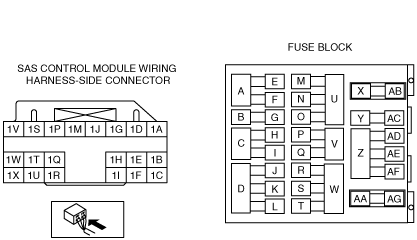DTC
B1317
SAS control module power supply voltage increases (16.1 V or more)
B1318
SAS control module power supply voltage decreases (less than 9 V)
DETECTION CONDITION
-
Warning
-
• Detection conditions are for understanding the DTC outline before performing an inspection. Performing an inspection with only detection conditions may cause injury due to an operating error, or damage the system. When performing an inspection, always follow the inspection procedure.
• When the SAS control module power supply voltage is not within 9―16 V.
POSSIBLE CAUSE
• Battery malfunction
• ENGINE 15 A fuse malfunction
• Open circuit or short in the wiring harness between the SAS control module and ignition relay
• Open circuit or power supply short in the wiring harness between the SAS control module and body ground
• SAS control module malfunction
